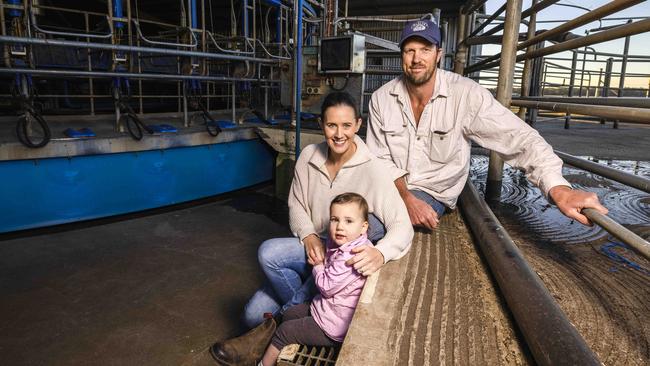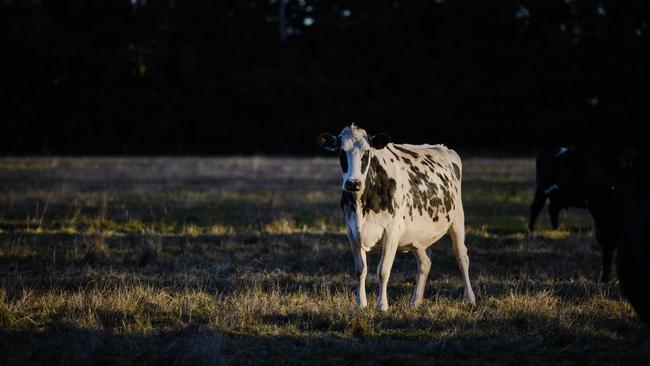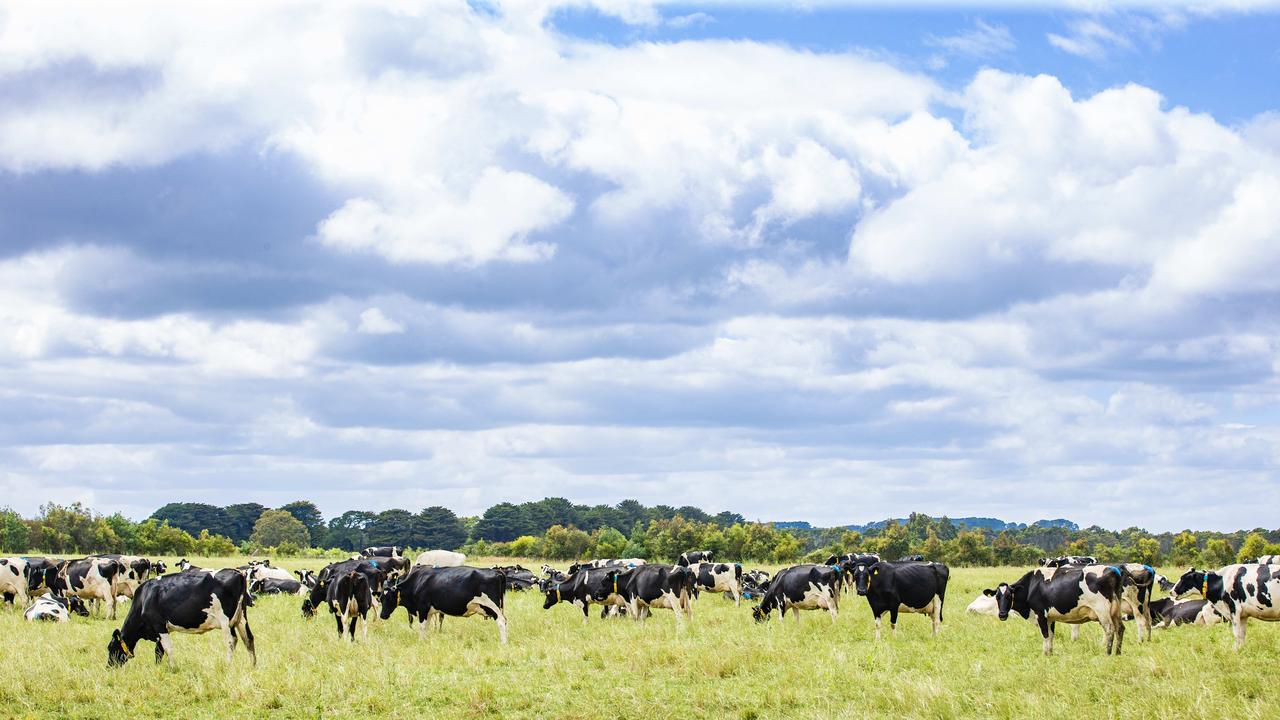Hinkley dairy: How a cooperative approach yields profits
With a focus on profits over production, here’s how the Hinkley family of Victoria have snagged a flat price for their milk.

Paul Hinkley might be the third generation of his family to farm at Cobden, in southwest Victoria, but he and his wife Sophie are putting their own spin on their dairy enterprise, determined to do things their own way.
This includes pulling away from supplying bigger milk processors, and instead selling milk to a new dairy group that prides itself on putting farmers before profits.
It’s a move which has brought stability and predictability to the enterprise, allowing the Hinkleys to best capitalise on their milk production when pasture growth is at its peak.
Both in their early 30s, with a young daughter and another baby on the way, Paul and Sophie both hail from farming families.

“We both went in different paths from farming originally,” Sophie said.
“I was originally doing a media degree in Melbourne, and Paul did a building apprenticeship. But Paul always loved the farm, and I was always eager to be rural.”
The couple have been operating their own dairy enterprise – a mixture of 324ha owned and 145ha leased – at South Purrumbete since 2010.
Paul’s parents Mick and Sherrill built their business from scratch, beginning with beef cattle before buying a dairy farm in 1990s.
Mick and Sherrill sold their dairy farm in 2008 and bought beef properties, including 140ha farm on which they built a dairy in 2010 which prompted Paul to begin milking and farming full time.
Since then, the Hinkleys have been able to purchase neighbouring farms, with 86ha added in 2018, 62ha in 2019, and the latest parcel of 36ha this year.
The Hinkleys rear their cattle on land which is “a good balance of low and high country”, with clay loam and sandy clay loam soils, and red gravel banks across the property.
Pastures are perennial ryegrass, with about 10 per cent renovated annually.
Stocking rate is 1.5 cows per hectare on the milking platform, grazed across 70 paddocks at an average size of 5ha. Water is accessed by dams and bores.

The biggest change for the family, Paul said, was the move away from a larger milk supplier to a more community-minded co-operative-style supplier.
For the past two years, the Hinkleys have supplied milk to South West Dairy Limited, a cohort of like-minded farmers determined to obtain a fair price for their milk, while growing their operations with confidence.
“I suppose we’ve felt that in the past … we’ve been discounted substantially in the spring months, in September, October, November. It’s when we produce more than 40 per cent of our milk,” Paul said.
“And then two years ago, Brad Couch, Duncan Morrison and John Hinkley came up with the idea … that we wanted to pool our milk and sell it to either a processor or somebody who’d buy it so we get paid a plat milk price.
“Ever since then, we haven’t looked back.”
Paul said while it was a “calculated risk”, the move to supply milk for South West Dairy has been “very beneficial” for the farm.
“We’re getting paid a flat new price … so every month it is the same, no matter seasonality,” Paul said.
“I suppose we just know that our hard work’s getting paid for in those spring months.”
Sophie spends time musing on the idea of suppling a cooportative, and tries to explain it in layman’s terms.
“I think the thing I really recognised was just how seductive it was for dairy farmers to be working based on those discounts the factories were offering. And in the end, that actually ended up being to the detriment of the farmers, when it isn’t as profitable to produce (milk)”, Sophie said.
“I think the incentive that this provides is that it actually gives the farmers that security in producing milk at times when there’s grass on the ground, and they’re not having to supplement their feed … and then that eats into the profitability of the business.”
Relieving some of the stress around milk pricing and returns has allows Paul and Sophie to focus more on consolidating their enterprise, with a focus on profitability and production.
The Hinkleys cows are fully dried off at present, with calving due to start around May 25.
“That’s the biggest thing about our system, is that we get to dry our cows fully off for two months. So we have that break to get the jobs done, and get away,” Paul said.
“And I like that the cows get a break too, they get a nice rest,” Sophie said.
“It’s like their maternity leave.”
About 420 cows produced 175,000 kilograms of milk solids last lactation.
But Paul is working to bring numbers up to 480 cows, producing between 195,000 to 200,000 kilograms of milk solids.
Paul employs a full time workers, along with one to two casual milkers in peak season.
Paul’s parents also assist with the younger stock.
Average rainfall is about 850mm, with the majority of rain falling in August.
Paul said this season has provided an “extremely wet winter and spring”, with a very dry summer stretching into autumn.
“The last winter proved to be quite challenging, as it was very wet here. And then in November it sort of stopped raining altogether. We probably didn’t really get that spring flush that we usually get, because it was so wet,” Paul said.
“You can’t control the seasons … what you can control is your cost, and that’s what we base our business on.”

The focus for the future, Paul said, is on profits over production.
That being said, the Hinkleys have boosted their milk production by about 10 per cent in the past five years, “due to better breeding and milking seasonally”.
Paul said local land prices were now closing in on $25,000 a hectare.
The biggest on-farm costs is fertiliser, with supplementary feed kept to a minimum.
“Our cost of production is about $3.70/kg of milk solids that’s including labour,” Paul said.
Farm consultant Kevin Maher is also utilised to look at yearly forecasts for the enterprise.
But when asked about future plans for expansion, the Hinkleys feel they have struck a perfect balance of herd and land size, and can now focus on maintaining profitability and labour expenditure.
“I think the pasture-based system was probably the most sustainable and environmentally-friendly system,” Paul said.
“It’s just a no-brainer going forward … probably the plans are just to consolidate the business and hone-in on some of the finer details.”
“We’ve been lucky, we got a couple of grants recently available to dairy farmers,” Sophie said.
“So we’ve been able to do a couple of things, like streamlining a little bit of the energy used in the dairy, with a new pump for the milk and a vacuum pump. But as Paul said, we believe that we’re quite sustainable anyway. It’s about refining a few things that can reduce energy costs.”
“We have seen an increase in people converting dairy farms to beef farms around the area,” Paul said.
“We are focused on maintaining the dairy industry and believe that seasonal dairy farming will remain profitable into the future.”





